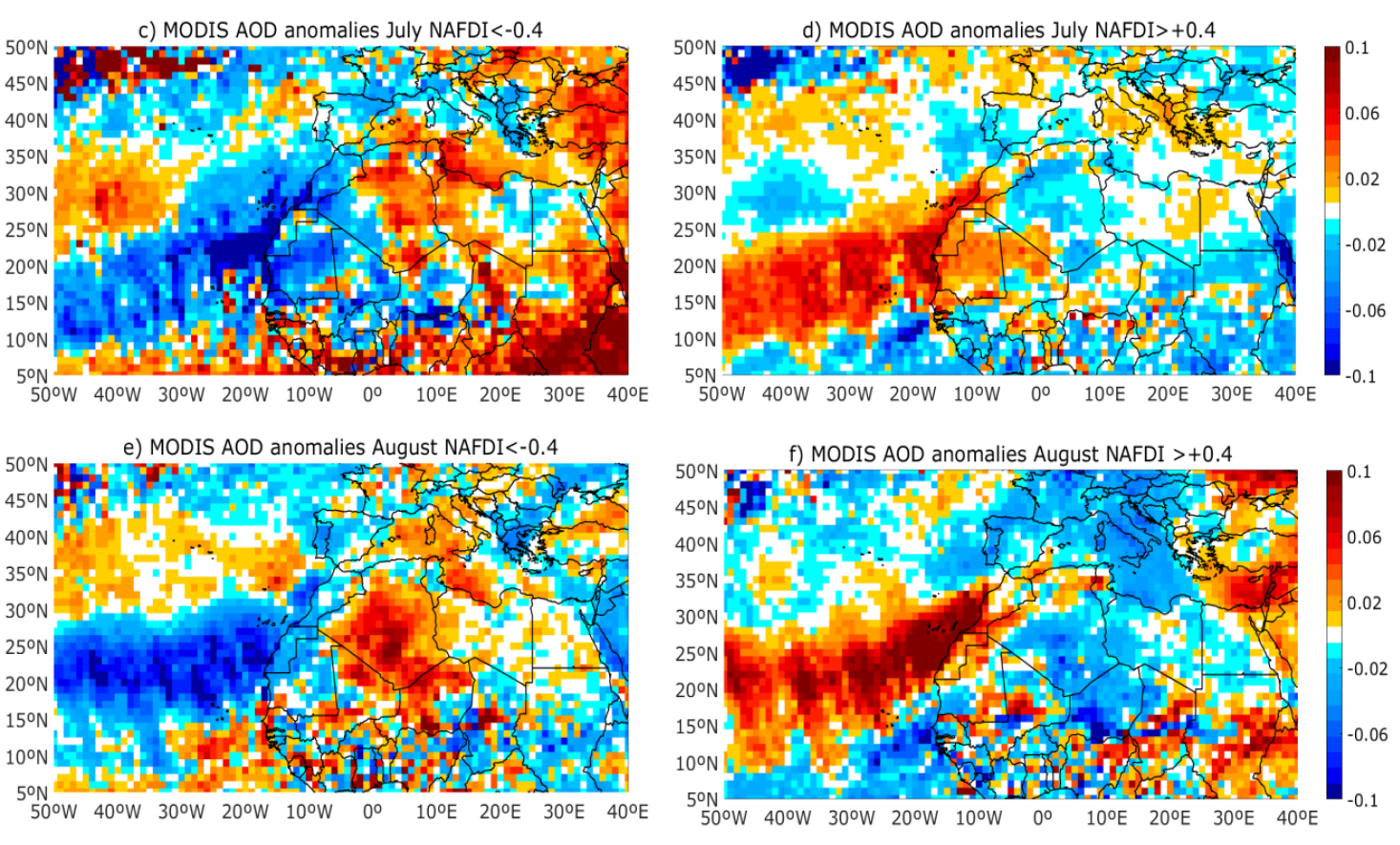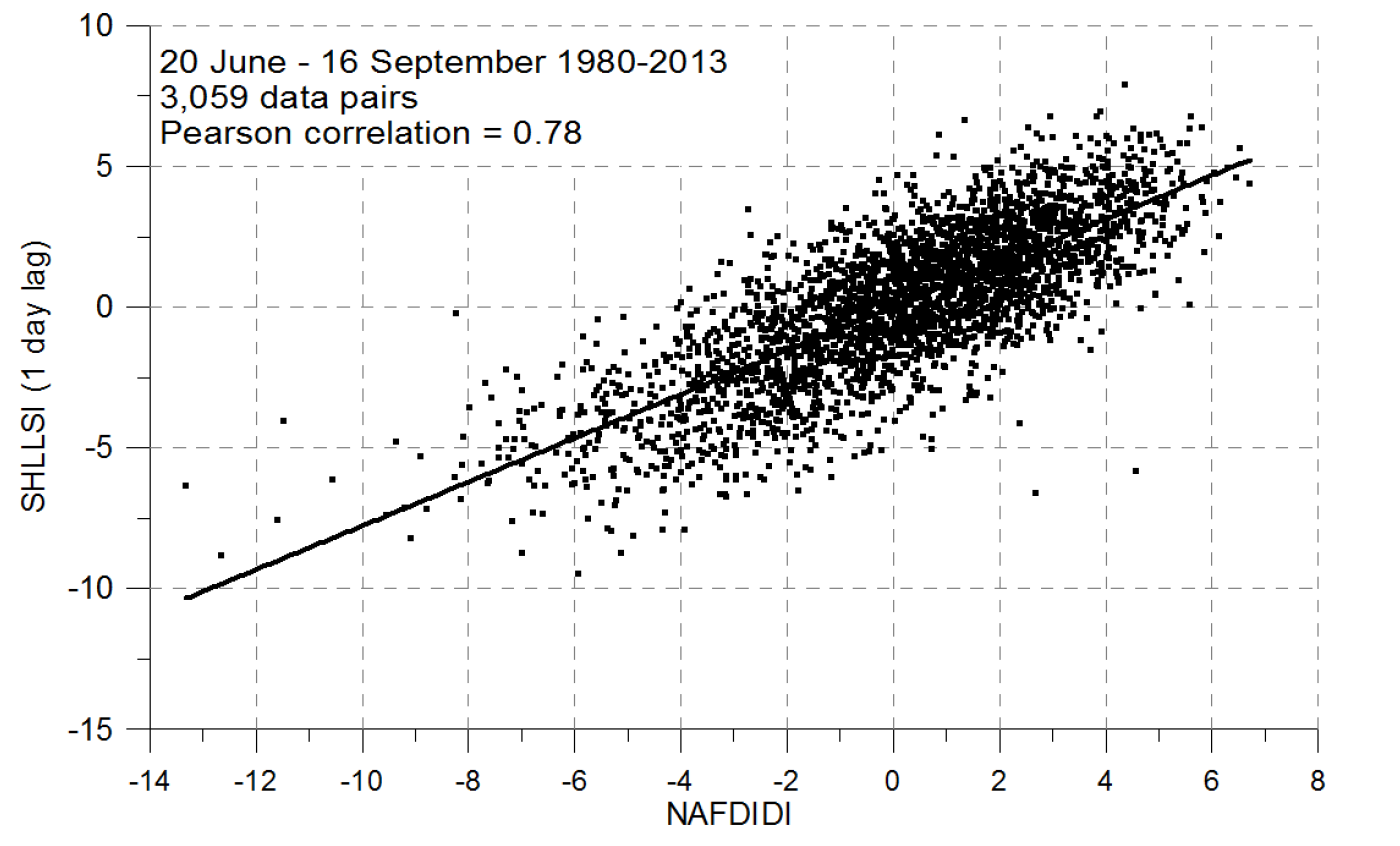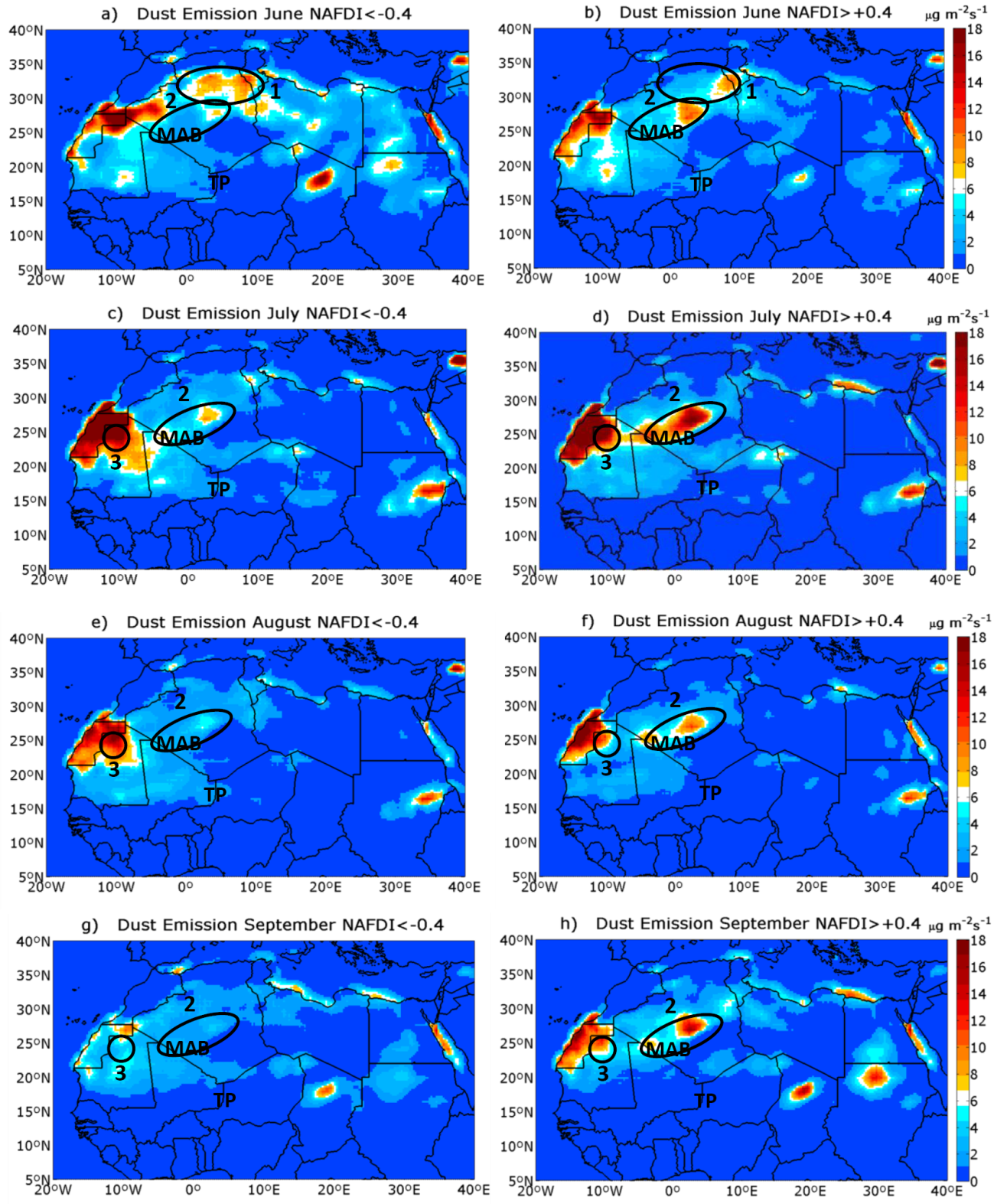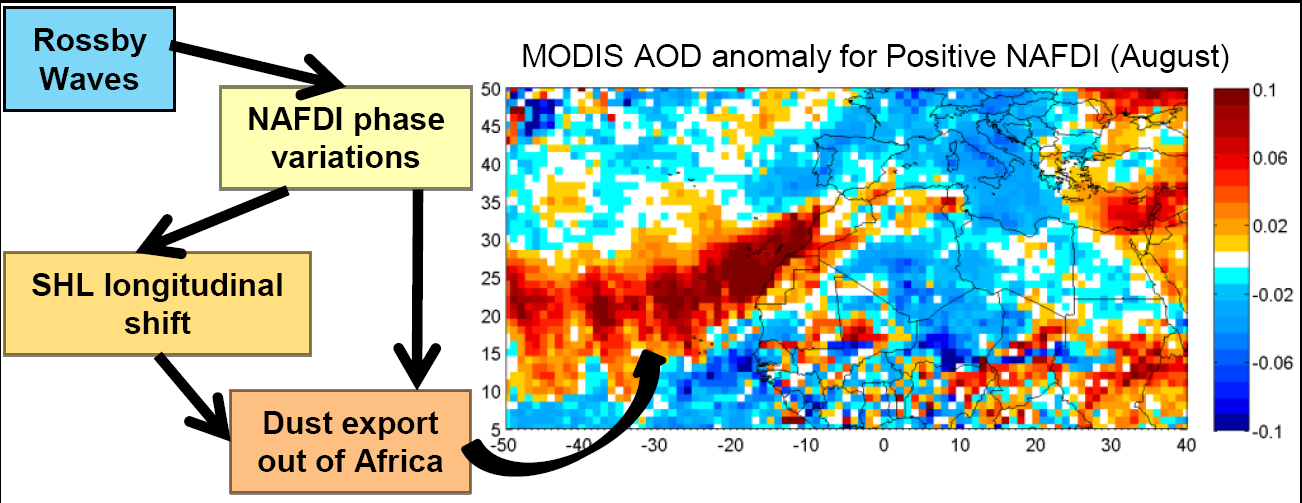The study titled “The pulsating nature of large-scale Saharan dust transport as a result of interplays between mid-latitude Rossby waves and the North African Dipole Intensity” has just been published in Atmospheric Environment.
![]()
The main objective of this study was to explain the atmospheric processes behind the intra-seasonal variations of dust outflows towards the Mediterranean and the subtropical North Atlantic Ocean. Daily and monthly data of MODIS Aerosol Optical Depth MODIS aerosols, NCEP / NCAR reanalysis, ECMWF reanalysis, and MACC reanalysis (today Copernicus CAMS) have been used in this study.
To achieve this goal, we have used the North African Dipole Intensity (NAFDI) concept recently introduced by Rodríguez et al. (2015), which is defined as the difference of the 700 hPa geopotential height anomaly between the subtropics and the tropics over Northern Africa. Essentially, NAFDI represents the large-scale anomaly of the geostrophic wind at 700 hPa (about 3000m altitude) over Northern Africa. Under positive NAFDI index, there are greater dust outflows towards the subtropical North Atlantic, and under negative NAFDI a positive dust anomaly is observed over the central and western Mediterranean. The first aim was to demonstrate that there is an intra-seasonal variation of NAFDI in summertime (June-September), and that it modulates Saharan dust outflows not only to the Atlantic but also to the Mediterranean basin.

AOD mean anomaly fields from MODIS (merged Deep-Blue and Dark-Target) for July and August months with negative (c and e) and positive (d and f) NAFDI (2003-2012).
The second challenge was to identify the physical mechanisms behind the connection between NAFDI and the Saharan Heat Low (SHL), which is well known to modulate numerous meso-scale meteorological processes that cause Saharan dust mobilization. The location and intensity of dust sources and dust outflows over Northern Africa depend to a large extent on the SHL position. The SHL can be found shifted farther east or west, and therefore conditioning the location and intensity of dust sources but, until now, the processes controlling these longitudinal shifts were unknown. On the other hand, the anomalies of different meteorological fields, such as temperature and wind at 925 hPa, as well as the geopotential thickness 700-925 hPa for positive (negative) NAFDI coincided with those found by other authors associated to the West (East) phase of SHL.
This was further evidence of the connection between NAFDI and SHL. But to prove it, available evidences are not enough. It was necessary to obtain statistically significant numerical results, and explanations based on physical mechanisms. For this, we worked with daily data in the period June-September 1980-2013, and introduced two new indexes, the daily NAFDI (NAFDIDI) and a new index that takes into account the SHL longitudinal shifts(SHLLSI). In this work it has been proved for the first time that there is a close relationship between SHL and NAFDI. Indeed, the correlation between the new SHLLSI index and NAFDIDI for the summer period is very high (0.7). No less important is the fact that this correlation increases to 0.78 when SHLLSI is delayed one day relative to NAFDIDI, clearly indicating that changes in NAFDI occur prior to shifts of the SHL.

NAFDIDI vs. SHLLSI one-day lagged for the summer period 1980-2013. The Pearson daily correlation value (0.78) is significant with a 99.999% confidence level.
To know the physical mechanisms behind this close relationship between NAFDI and the SHL, we used the energy equation of the atmospheric dynamics with daily NCEP / NCAR reanalysis data for the aforementioned study period. The conclusion of this analysis is that the horizontal differential advection of the temperature, due to the horizontal velocity anomaly associated to NAFDI, unequivocally modulates the evolution of the longitudinal shifts of the SHL.
This result indicates, in turn, that the changes in NAFDI could be related to the intensification and the weakening of the sources of dust in the central and Western Sahara. Thus, a positive NAFDI favours dust mobilization in the Western Sahara, northern Mauritania and central Algeria. This has been corroborated by preliminary simulations of dust emissions made from MACC reanalysis data (now, Copernicus CAMS).

Mean dust emission (µg m-2s-1) calculated from MACC reanalysis (now Copernicus CAMS Reanalysis) for June, July, August, and September months with negative (a, c, e, and g) and positive (b, d, f, and h) NAFDI (2003-2012).
However, the most important question still remained to be answered: What atmospheric mechanism explains the variations of NAFDI and SHL showing a variable period between 10 and 30 days?
Based on the very interesting work of Chauvin et al. (2010), and bearing in mind the general principle in physics by which larger spatial scale processes modulate smaller processes, we realized that those mid-latitude Rossby waves (MLRWs) penetrating into the lower troposphere over Northern Africa might be the answer. In addition, these waves have a timescale of 10-30 days. However, demonstrating the role played by Rossby waves without having complex modelling systems was not a trivial task.
To address this latter study we chose two simple parameters to be calculated: Omega at 500 hPa (OM500) over northern Algeria, which accounts for the penetration of mid-latitude Rossby waves into the Northern Africa lower troposphere, and the wind anomaly at 300 hPa (WA300) on southern Morocco, in order to quantify the phase and amplitude of mid-latitude Rossby waves. These parameters, at the respective regions, showed the highest correlations with NAFDI.
Well, the correlation between NAFDIDI (NAFDI daily index) and a linear relationship of OM500 and WA300 (LCWAOM) gives a correlation coefficient of 0.656 (significant to 99.999%). In addition, the power spectra of NAFDIDI, SHLLSI and the linear combination of OM500 and WA300, on the 10-30 day time scale, show that the most intense NAFDIDI peaks are present in the SHLLSI power spectrum, and a large part of them are also present in that of LCWAOM.

Conceptual summary of this study
In summary this paper shows that the intra-seasonaI variations of NAFDI are modulated by those mid-latitude Rossby waves that penetrate well into the North Africa low troposphere, and this modulation is transmitted downward since NAFDI modulates, in turn, the longitudinal shifts of the SHL. All this leads us to conclude that these mid-latitude Rossby waves cause the pulsating nature of Saharan dust flows observed over the central and western Mediterranean basin and over the subtropical North Atlantic.
The full reference of this article is:
Cuevas, E., A.J. Gómez-Peláez, S. Rodríguez, E. Terradellas, S. Basart, R.D. García, O.E. García, S. Alonso-Pérez, The pulsating nature of large-scale Saharan dust transport as a result of interplays between mid-latitude Rossby waves and the North African Dipole Intensity, Atmospheric Environment, 167, 586-602, ISSN 1352-2310, https://doi.org/10.1016/j.atmosenv.2017.08.059, 2017.
It can be downloaded at:
http://www.sciencedirect.com/science/article/pii/S1352231017305757






